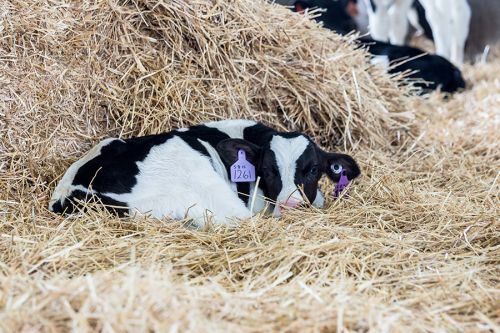Fine-tune your calf barn cleaning procedures
Posted: August 7, 2017 | Written By: Dr. Anne Proctor, Form-A-Feed Dairy Technical Specialist

What sets farms with great calf health apart from those that struggle to get calves started? Sanitation. It is a bigger investment of time than money and is certainly near the top of the list of important criteria for getting calves off to a good start.
The fewer disease-causing organisms the calf is exposed to, the lower the risk she will get sick.
Manure is the enemy; scours organisms spread by manure of an infected calf getting in the mouth of a healthy calf. The more exposure, the more likely the calf will get sick. Exposure starts in the calving area with manure from adult cows getting in the calf’s mouth, or from it touching the walls, bedding, the cow’s flank – and even from the calf licking itself.
Hands are another common source of infection. Make sure employees caring for newborns have disposable gloves to put on when handling the calf. The hands that helped move the cow into the calving pen probably carry manure from the hair coat of the cow.
Using those same hands to get the nipple in the calf’s mouth is an easy way for bacteria to spread. Make sure gloves are readily available in the maternity area and employees use them when handling the newborn calf.
In addition to exposure in the calving environment, sometimes there is a piece of equipment not getting cleaned thoroughly and transferring bacteria to calves. It may be the colostrum collection bucket, the bottle or nipple colostrum is fed with, the walls of the newborn calf pen, the warming box floor, etc.
The feeding equipment used every day also needs to be cleaned and sanitized between uses. When we see calf after calf coming down with scours at about the same age, we search for something every calf comes in contact with to find the source.
It is often something simple which has been overlooked in the cleaning process. If you’re struggling with sick calves, reduce exposure by fine-tuning your cleaning procedures.
While cleaning calf equipment sounds like an easy task, milk is a difficult substance to clean off of surfaces. You need hot water to remove the fat, but the heat bakes the protein onto the surface. Using warm water to get rid of the protein leaves a film of fat.
When fats and proteins stick to the surface of equipment, they form a biofilm, a nutrient-rich layer in which bacteria grow.
The biofilm protects bacteria from the cleaning process and results in equipment that appears clean but has bacteria on the surface. The cleaning process not only needs to remove fat and protein from surfaces but prevent the formation of a biofilm.
Dr. Don Sockett at the Wisconsin Veterinary Diagnostic Laboratory recommends producers follow a six-step procedure. First, rinse with warm water. Soak in hot water (140ºF) that contains a chlorinated alkaline detergent, then wash in hot water (140ºF) with a chlorinated alkaline detergent. Be sure to scrub with a brush inside and out.
You’ll need more than one brush. Invest in a brush for the inside of bottles, one for nipples, one that fits the tube of the tube feeder and one for buckets or flat surfaces. Next, rinse with cold water containing 50 parts per million (ppm) of chlorine dioxide.
Finally, allow equipment to dry thoroughly. Use a rack or hang equipment so water can drain out and air can flow in.
Before using calf equipment, spray it with a 50 ppm solution of chlorine dioxide. Chlorine dioxide sprayed on feeding equipment is safe for the calf and does not need to be rinsed before using. The process to wash calf pens and maternity areas is the same – rinse, wash and scrub, rinse and sanitize – use a 100 ppm solution of chlorine dioxide to sanitize.
Chlorine dioxide is different than household bleach and is the preferred sanitizer for calf equipment. Many farms now use chlorine dioxide for calf-feeding equipment and to disinfect calf pens or hutches after washing. Your calf specialist or animal health supply company will be able to direct you to a supplier.
Raising healthy calves starts by using good sanitation practices to reduce exposure to pathogens in the environment. Cleaning may not be a favorite job on the farm, but to quote Sockett, “You cannot disinfect filth.” In order for the disinfectant to do its job, the surface must be clean.
The investment in time and effort pays off in healthy calves. Get yourself or your team set up with the equipment needed to make the job efficient and make proper cleaning and disinfecting part of the daily routine.
Article originally written for and published by Progressive Dairyman.